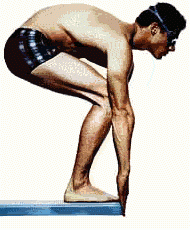










Swimming has been part of the modern Olympic Games since inception in 1896. Along with the other aquatic disciplines of diving, synchronised swimming and water polo, the sport is governed by the Fédération Internationale de Natation (FINA).
History:
Competitive swimming in Europe started around 1800, mostly using breaststroke. In 1873 John Arthur Trudgen introduced the trudgen to Western swimming competitions, after copying the front crawl used by Native Americans. Due to a British disregard for splashing, Trudgen employed a scissor kick instead of the front crawl's flutter kick. Swimming was part of the first modern Olympic games in 1896 in Athens. In 1902 Richard Cavill introduced the front crawl to the Western world. In 1908, the world swimming association, Fédération Internationale de Natation (FINA), was formed. Butterfly was developed in the 1930s and was at first a variant of breaststroke, until it was accepted as a separate style in 1952.
Officials:
There are several types of officials:
* A starter sends the swimmers off the blocks and may call a false start if a swimmer leaves the block before the starter sends them;
* Finish judges determine the order of finish and make sure the swimmers finish in accordance with the rules (two hands simultaneously for breaststroke and butterfly, on the back for backstroke, etc.)
* Turn judges check that the swimmers' turns are within rules;
* Stroke judges check the swimmers' strokes;
* Timekeepers time the swimmers' swims;
* The referee takes overall responsibility for running the race and makes the final decisions as to who wins the competition.
Swimwear:
Competitive swimwear seeks to improve upon bare human skin for a speed advantage. For extra speed a swimmer wears a body suit, which has rubber or plastic bumps that break up the water close to the body and provides a small amount of thrust--just barely enough to help a swimmer swim faster.
Brands include: Arena, Speedo, TYR, Nike, Dolfin
Regular practice and competition-swimwear
Men:
Men's most used practice swimwear include speedos(briefs) and jammers.
Women:
Women wear one piece suits with different backs for competition. Although, there are different style two piece suits that can be worn to compete in as well. Backs vary mainly in strap thickness and in geometric design of the back. Most common different style backs include: racerback, diamondback, butterflyback. There are also different style lengths that include: three quarter length (knee length suit), full body (down to your ankels), regular length (shoulders to hips) and bikini style (2 piece).
Drag suits:
Drag suits are used for increasing the resistance against the swimmer in order to help adjust the swimmer to drag. This way when swimmers switch back normal practice suits they swim faster as a result of feeling less resistance.
Drag shorts:
Drag shorts like drag suits are worn in training and are also used to increase drag so that when taken off in racing it feels easier and you have less reistance.
Records in swimming:
The foundation of FINA in 1908 signalled the commencement of recording the first official world records in swimming. At that time records could be established in any swimming pool of length not less than 25 yards, and records were also accepted for intermediate distance split times from longer distance events. The Danish swimmer Ranghild Hveger established forty-two records between 1936 and 1942 due to these rules.
Records in events such as 300 yd, 300 m, 1000 yd and 1000 m freestyle, 400 m backstroke, 400 m and 500 m breaststroke were no longer ratified from 1948. A further removal of the 500 yd and 500 m freestyle, 150 m backstroke and 3×100 m medley relay from the record listings occurred in 1952.
In 1952 the national federations of the United States and Japan proposed at the FINA Congress the separation of records achieved in long course and short course pools, however it was four more years for action to come into effect with Congress deciding to retain only records held in 50 m pools as the official world record listings.
By 1969 there were thirty-one events in which FINA recognised official world records – 16 for men, 15 for women – closely resembling the event schedule that was in use at the Olympic Games.
The increase in accuracy and reliability of electronic timing equipment led to the introduction of hundredths of a second to the time records from 21 August 1972.
Records in short course (25 m) pools began to be officially approved as "short course world records" from 3 March 1991. Prior to this "record" times were not officially recognised but were regarded a "world best time" (WBT). From 31 October 1994 records in 50 m backstroke, breaststroke and butterfly records were added to the official record listings.
FINA currently recognises world records in the following events for both men and women.
* Freestyle: 50 m, 100 m, 200 m, 400 m, 800 m, 1500 m
* Backstroke: 50 m, 100 m, 200 m
* Breaststroke: 50 m, 100 m, 200 m
* Butterfly: 50 m, 100 m, 200 m
* Individual medley: 100 m (short course only), 200 m, 400 m
* Relays: 4×100 m freestyle, 4×200 m freestyle, 4×100 m medley
Wednesday, August 12, 2009
Swimming
Subscribe to:
Post Comments (Atom)


0 comments:
Post a Comment